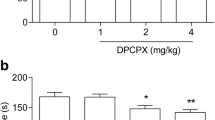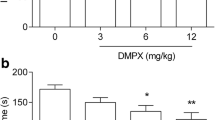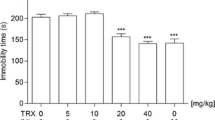Summary
MK-801, a non-competitive NMDA receptor antagonist, induced the locomotor hyperactivity in rats. Imipramine (IMI), amitriptyline (AMI), citalopram (CIT) given acutely increased the MK-801-induced locomotor hyperactivity. Mianserin (MIA) showed a similar but weaker effect. Haloperidol completely blocked the hyperactivity induced by the antidepressant drug (AD) + MK-801. Prazosin had an only weak antagonistic effect. Repeated treatment with AD increased the MK-801 locomotor hyperactivity to a greater extent than acute treatment. This effect was completely blocked by haloperidol and only partly by prazosin.
The obtained results indicate that the dopamine system may be involved, at least in part, in the potentiating effect of the combined treatment with AD + MK-801.
Similar content being viewed by others
References
Arnt J, Hyttel J, Fredericson Overo K (1984) Prolonged treatment with the specific 5-HT- uptake inhibitor citalopram: effect of dopaminergic and serotonergic function. Pol J Pharmacol Pharm 36: 221–230
Carlsson M, Carlsson A (1989a) Dramatic synergism between MK-801 and clonidine with respect to locomotor stimulatory effect in monoamine-depleted mice. J Neural Transm 77: 65–71
Carlsson M, Carlsson A (1989b) The NMDA antagonist MK-801 causes marked locomotor stimulation in monoamine-depleted mice. J Neural Transm 75: 221–226
Carlsson M, Svensson A (1990) Interfering with glutamatergic neurotransmission by means of NMDA antagonist administration discloses the locomotor stimulatory potential of other transmitter systems. Pharmacol Biochem Behav 36: 45–50
Clineschmidt BV, Gregory EM, Bunting PR, Papp NL (1982) Central sympathomimetic activity of (+)-5-Methyl-10,11-dihydro-5 H-dibenzo(a,d)cyclohepten-5,10-imine (MK-801), a substance with potent anticonvulsant, central sympathomimetic and apparent anxiolytic properties. Drug Dev Res 2: 135–145
De Montis GM, Devoto P, Gessa GL, Meloni D, Porcella A, Saba P, Serra G, Tagliamonte A (1989) Chronic imipramine reduces3H-SCH 23390 binding and dopamine sensitive adenylate cyclase in the limbic system. Eur J Pharmacol 167: 299–303
De Montis GM, Devoto P, Gessa GL, Meloni D, Porcella A, Saba P, Serra G, Tagliamonte A (1990a) Central dopaminergic transmission is selectively increased in the limbic system of rats chronically exposed to antidepressants. Eur J Pharmacol 180: 31–35
De Montis GM, Devoto P, Gessa GL, Porcella A, Serra G, Tagliamonte A (1990b) Possible roles of DA receptors in the mechanism of action of antidepressants. In: Gessa GL, Serra G (eds) Advances in the biosciences 77. Pergamon Press, Oxford New York, pp 147–157
Dimpfel W, Spüler M (1990) Dizocilpine (MK-801), ketamine and phencyclidine: low doses affect brain field potentials in the frelly moving rat in the same way as activation of dopaminergic transmission. Psychopharmacology 101: 317–323
Halaris A, Belendiuk K, Freedman DX (1975) Antidepressant drug affect dopamine uptake. Biochem Pharmacol 24: 1896–1898
Hiramatsu M, Cho AK, Nabeshima T (1989) Comparison of the behavioral and biochemical effects of the NMDA receptor antagonists MK-801 and phencyclidine. Eur J Pharmacol 166: 359
Kashihara K, Hamamura T, Okumura K, Otsuki S (1990) Effect of MK-801 on endogenous dopamine release in vivo. Brain Res 528: 80–82
Klockgether T, Turski L, Loschmann P-A, Wachtel H (1990) N-Methyl-D-aspartate antagonists stimulate locomotor activity in monoamine depleted rats: implications for the therapy of Parkinson's disease. In: Lubec G, Rosenthal GA (eds) Amino acidschemistry, biology and medicine. Escom, Leiden, pp 276–280
Koek W, Woods JH, Winger GD (1988) MK-801, a proposed noncompetitive antagonist of excitatory amino acid neurotransmission, produces phencyclidine-like behavioural effects in pigeons, rats and rhesus monkeys. J Pharmacol Exp Ther 245: 969–974
Maj J (1984) Mechanism of action of antidepressant drugs given repeatedly: changes in the responses mediated by noradrenaline (α1) and dopamine receptors. In: Paton W, Michell J, Turner P (eds) Proceedings of the IUPHAR 9th International Congress of Pharmacology, London 1984. Macmillan Press, vol 3, pp 137–143
Maj J (1986) Repeated treatment with antidepressant drugs: responses mediated by brain dopamine receptors. In: Hippius H, Klerman GL, Matussek N (eds) New results in depression research. Springer, Berlin Heidelberg New York, pp 90–98
Maj J, Mogilnicka E, Klimek V (1977) Dopaminergic stimulation enhances the utilization of noradrenaline in the central nervous system. J Pharm Pharmacol 29: 569–570
Maj J, Sowińska H, Baran L, Gancarczyk L, Rawlw A (1978) The central antiserotonergic action of mianserin. Psychopharmacology 59: 79–84
Maj J, Rogóż Z, Skuza G, Sowińska H (1984) Repeated treatment with antidepressant drugs increase the behavioural response to apomorphine. J Neural Transm 60: 273–282
Maj J, Rogóż Z, Skuza G, Sowinska H (1985) The effects of repeated treatment with antidepressant drugs on the action of D-amphetamine and apomorphine in rats. In: Keleman K, Magyar K, Vizi ES (eds) Neuropharmacology '85. Akademiai Kiado, Budapest, pp 133–139
Maj J, Wedzony K, Skuza G (1986) Subsensitivity of presynaptic and supersensitivity of postsynaptic dopaminergic receptors as a result of repeated administration of antidepressant drugs. In: Knoll J, Keleman K (eds) Advances in pharmacological research and practice. Proc 4th Congress of the Hungarian Pharmacological Society, vol 2. Akademiai Kiado, Budapest, pp 47–55
Maj J, Wedzony K, Klimek V (1987) Desipramine given repeatedly enhances behavioural effects of dopamine and d-amphetamine injected into the nucleus accumbens. Eur J Pharmacol 140: 179–185
Maj J, Rogóz Z, Skuza G (1991) Locomotor hyperactivity induced by MK-801 in rats. Pol J Pharmacol Pharm (in press)
Martin GE (1986) Catecholamine release within the striatum of the freely moving rat. Ann NY Acad Sci 473: 151–159
Martin-Iverson MT, Leclere JF, Fibiger HC (1983) Cholinergic interactions and the mechanism of action of antidepressants. Eur J Pharmacol 94: 193–201
Mehta AK, Ticku MK (1990) Role of N-methyl-D-aspartate (NMDA) receptors in experimental catalepsy in rats. Life Sci 46: 37–42
Meldrum BS (1985) Possible therapeutic applications of antagonists of excitatory amino acid neurotransmitters. Clin Sci 68: 113–122
Morelli M, Di Chiara G (1990) MK-801 potentiates dopaminergic D1 but reduces D2 responses in the 6-hydroxydopamine model of Parkinson's disease. Eur J Pharmacol 182: 611–612
Plaźnik A, Kostowski W (1987) The effects of antidepressants and electroconvulsive shock on the functioning of the mesolimbic dopaminergic system: a behavioural study. Eur J Pharmacol 135: 389–396
Randrup A, Braestrup C (1977) Uptake inhibition of biogenic amines by newer antidepressant drugs: relevance to the dopamine hypothesis of depression. Psychopharmacology 53: 309–314
Reynold IJ, Miller RJ (1988) Tricyclic antidepressants block N-methyl-D-aspartate receptors: similarities to the action of zinc. Br J Pharmacol 95: 95–102
Schmidt WJ, Bubser M (1989) Anticataleptic effects of N-methyl-D-aspartate antagonist MK-801 in rats. Pharmacol Biochem Behav 32: 621–623
Snell LD, Yi S-J, Johnson KM (1988) Comparison of the effect of MK-801 and phencyclidine on catecholamine uptake and NMDA-induced norepinephrine release. Eur J Pharmacol 145: 223–226
Spyraki C, Fibiger HC (1981) Behavioural evidence for supersensitivity of postsynaptic dopamine receptors in the mesolimbic system after chronic administration of desipramine. Eur J Pharmacol 74: 195–206
Tiedtke PJ, Bischoff C, Schmidt WJ (1990) MK-801-induced stereotypy and its antagonism by neuroleptic drugs. J Neural Transm [Gen Sect] 81: 173–182
Trullas R, Skolnick P (1990) Functional antagonists at the NMDA receptor complex exhibit antidepressant actions. Eur J Pharmacol 185: 1–10
Wong EHF, Kemp JA, Priestley T, Knight AR, Woodruff GN, Iversen LL (1986) The anticonvulsant MK-801 is a potent N-methyl-D-aspartate antagonist. Proc Natl Acad Sci USA 83: 7104–7108
Wong EHF, Knigh AR, Woodruff GN (1988) [3H] MK-801 labels a site on the N-methyl-D-aspartate receptor channel complex in rat brain membranes. J Neurochem 50: 274–281
Author information
Authors and Affiliations
Rights and permissions
About this article
Cite this article
Maj, J., Rogóż, Z. & Skuza, G. Antidepressant drugs increase the locomotor hyperactivity induced by MK-801 in rats. J. Neural Transmission 85, 169–179 (1991). https://doi.org/10.1007/BF01244943
Received:
Accepted:
Issue Date:
DOI: https://doi.org/10.1007/BF01244943




